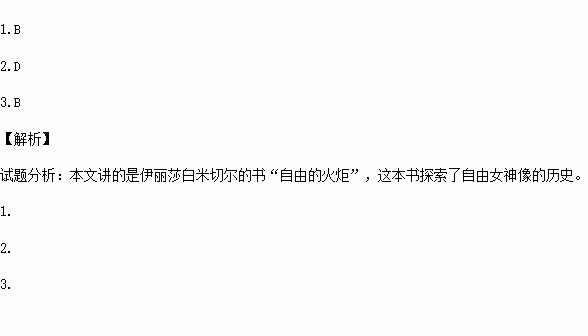题目内容
阅读理解。
Elizabeth Mitchell’s new “Liberty’s Torch” is the fascinating story of how the Statue of Liberty came to be. The Statue of Liberty’s rough history is explored in “Liberty’s Torch”.
Frederic Auguste Bartholdi is an all-but-forgotten figure in American history. He was, however, responsible for one of the most enduring symbols of the United States: the Statue of Liberty. A Frenchman from Alsace, he designed and built the Statue of Liberty which stood on Bedloe’s Island in New York Harbor. How this statue came to be is the fascinating subject of Elizabeth Michell’s new book “Liberty’s Torch”.
The power of Mitchell’s narrative is convincing(令人信服的). We recognize the Statue of Liberty now as a symbol of hope and opportunity for a nation of immigrants. At the time, though, people could not see that-nor did they even imagine that. Instead, the construction of the statue was born of one man’s desire to set up a great monument.
For this reason, perhaps, “Liberty’s Torch” relies on Bartholdi as the connecting thread. Bartholdi went to Egypt to make photographic copies of the main monuments. On the boat, Bartholdi met and began a lifelong relationship with Ferdinand de Lesseps, the man who would build the Suez Canal. Maybe it was this friendship, or maybe it was seeing Egypt’s huge monuments, but finally the trip inspired Bartholdi’s dream to create the largest statue ever built. Failure to bring this to completion in Egypt, followed by his exile (流放) from Paris, led Bartholdi to sail to America.
By explaining the Statue of Liberty’s hard history and showing Bartholdi’s brave spirit, Mitchell has done a great service.
1.It can be inferred from the text that ________.
A. American people have never forgotten Frederic August Bartholdi
B. the Statue of Liberty wasn’t originally regarded as a symbol of hope
C. Bartholdi finished the Suez Canal
D. Bartholdi was a famous architect from Egypt.
2.What was the main reason for Bartholdi to build the Statue of Liberty?
A. To finish his education in the arts.
B. To mark his friendship with Ferdinand.
C. To create something better than Egyptian monuments.
D. To achieve his dream to create the largest statue.
3.What type of writing is the passage?
A. A travel guide. B. A book review
C. An announcement D. An architecture report.

